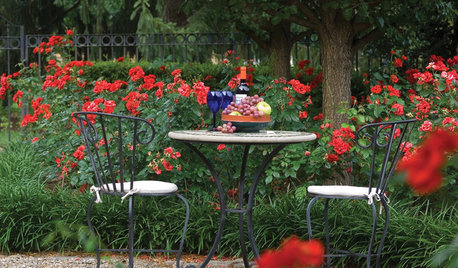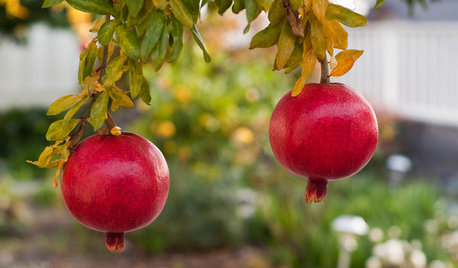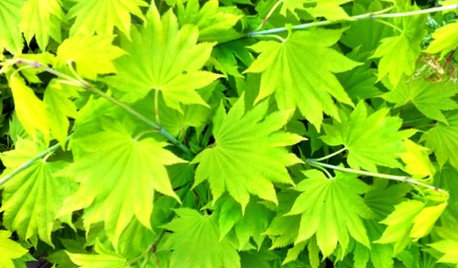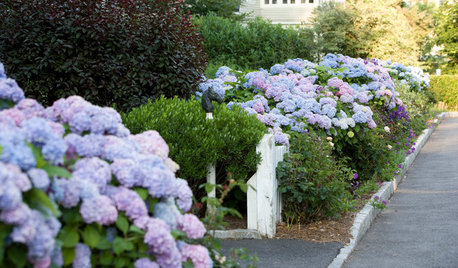Winner & losers roses for your soil /climate/rootstock
I had lots of hybrid teas grafted on Dr. Huey that black spotted badly my last house of acidic clay, mulched with acidic pine bark despite spraying. I'm checking to see if being own-roots is healthier, or is it keeping a dry & alkaline surface?
My present house is alkaline limestone clay, pH 7.7, 40" of rain, hot 80-100 degrees, zone 5a winter (23" snow). Most 52+ roses are very healthy as OWN-ROOTS:
BLOOM WELL: All Romanticas & Meilland roses & most Austins & OGRs and floribundas as own-roots.
STINGY: Jacques Cartier, Austin Eglantyne, Charles Darwin, Nahema, Lauren. Mini-roses don't survive zone 5a winter.
DISEASE: Bridal Pink own-root (surfaced with alfalfa meal at pH 5.7), and Heirloom Hybrid Tea grafted on Dr. Huey black spotted in a bed mulched with wet acidic leaves.
I'm doing a research to see if own-roots are healthier than grafted on Dr. Huey. Any info. is greatly appreciated. THANK YOU.
Below is my favorite Romantica, Sweet Promise 2007, it can handle poor-drainage clay where grafted Knock-out on Dr. Huey could not.

This post was edited by Strawberryhill on Sat, May 25, 13 at 12:38
Comments (15)
strawchicago z5
Original Author10 years agoThank you, Kippy, for the info. I love what you wrote: "And how long in the garden; over time one might find a bad rose becomes good as it matures. " That gives me hope for Roseseek-bred Lauren rose!
The bigger the root compared to the mass above, the better. Ps8ker in Roses Forum has better soil than mine, at pH 7.5 versus my 7.7. I need 3 times more potassium, 2 times more phosphorus, and way-more calcium than Ps8ker according to EarthCo. soil company.
However, Psk8er has black spots ... I don't with own-roots here, with keeping the surface of soil dry and alkaline so BS can't germinate. Grafted on Dr. Huey's bud union can be damaged through dryness in stores, acid, winter, or flood.
Grafted on Dr. Huey also has a bigger mass above for the root to support ... more demand for water and nutrients. William Shakespeare 2000 as own-root is always perfectly clean. He's so tiny less than 1' x 1', that my NOT watering him, or low-soil nutrients doesn't matter much.
Since the rose park here spray every 10 days, I never see black spots until last summer when roses got so big & tall due to a mild winter. There's less water and nutrients to support a 7 feet tall Jude the Obscure, versus a 2.5 feet tall Jude in normal winter-kill.
Kippy is right about sun, fertilizer, and soil factors: Paul Neyron had wimpy root in a bad soil, very hilly and hot southwest sun ... he black spotted on acid-high-nitrogen fertilizer, both from the stress of high-salt fertilizer, and hot sun.
Then I moved Paul N. to partial shade, good fluffy soil ... zero nitrogen fertilizer. His root got big, and now 100% clean. I saw what phosphorus did to the roots of my petunia in a pot: tripled the root growth. I will test potassium and calcium late fall, where BS-pressure is high.
This year I tested NPK of 0-52-34 on Sonia Rykiel and Annie L. McDowell ... both broke out in tons of buds ... very healthy in constant rain. The bigger the roots compared to the top mass, the more water & nutrients extracted to produce blooms and fight diseases.
This post was edited by Strawberryhill on Tue, May 28, 13 at 11:18
Related Professionals
Allen Landscape Architects & Landscape Designers · Manorville Landscape Architects & Landscape Designers · Marina Landscape Architects & Landscape Designers · Wilmington Landscape Contractors · Cordele Landscape Contractors · Englewood Landscape Contractors · Huntington Landscape Contractors · Paso Robles Landscape Contractors · Tinton Falls Landscape Contractors · Maple Heights Landscape Contractors · Clearfield Landscape Contractors · Baltimore Siding & Exteriors · Black Forest Siding & Exteriors · West Elkridge Siding & Exteriors · North Adams Siding & Exteriorsportlandmysteryrose
10 years agoStrawberryhill
I may have to respond over a couple of postings if I get called to parenting duties before completing my reply. It's challenging to type for any length of time with a 2.5-year-old in the house.
I enjoy reading about your chemistry experiments. I have a list of some I'd like to try. The content of my posting will lack the hard scientific evidence of yours, but if you fish through my convoluted ramblings perhaps you'll discover some small item that will prove useful to your data collection.
I've gardened in TX and MN. I must live in something akin to paradise now. My garden is in Portland, OR. Nice inland location west of the Cascades. Zone 8. Soil: red clay on the acidic side. Cloud cover and wet weather in late fall, winter, and spring-early summer. Lately, the cool wetness lasts into mid June. A little rain here and there in later June, July, August, and September, but our warmer months are considered "drought summers." I hose water once per week in the summer except when temps hit 100's for that week or two in August. Then I water the vulnerables and flowering things two times per week.
I amend the soil with a local nursery's 3-way soil blend and my home-made compost. I haven't tested soil pH in a number of years, but I've noticed that my hydrangeas aren't as blue as they were at my last PDX residence. My current "blue" hydrangeas (Nikko, Blaumeise, and Gentian Dome) tend to bloom pinkish lavender. I'm guessing their color indicates a pH somewhere around 6.8 or so. I need to get out in the yard with a test kit....
I grow mostly own-root roses these days, but I have a few grafted ones as well. I grew quite a lot of grafted roses in past gardens, and I used grafted roses in many clients' gardens. My understanding is that all my current grafted roses are growing on Dr. Huey rootstock.
My current OGRs--not counting 2 teas and Barcelona/FdB--include 4 gallicas, 4 albas, 2 damasks, 4 Portland damask perpetuals, 2 Lady Banks, 2 hybrid perpetuals (one a mystery rose imposter from Heirloom) and one of each of these: bourbon, noisette, noisette-tea, multiflora hybrid rambler, and pimpinellifolia hybrid. They all grow like wild things on their own roots in sun to partial shade. (I'll address the teas later.)
My own-root hybrid musks grow a tiny bit slower--sun or partial shade--but not much. All the above are completely healthy except my gallica 'Officinalis,' gallica 'Versicolor,' and 'Zepherine Drouhin.' These do get powdery mildew. 'Zeph,' 'Violette,' and 'Bland de Vibert' get some blackspot at times. The 2 gallicas and 'Zeph' and 'Violette' are planted in my narrow west side yard between the exterior of my house and a 6' wood fence. Air circulation is poor. Since I'm a teacher and I'm raising a toddler while caring for aging parents, these poor rose souls haven't been treated for any of their conditions. The darlings thrive and bloom just the same.
To be continued....
Carol
portlandmysteryrose
10 years agoMy Austins are slow to develop when grown on their own roots. This seems to be true for all of the following past and present own-root Austins: Abe Darby, Tamora, Tea Clipper, Heritage, Tradescant, William Shakespaere (original), The Prince, Sis Elizabeth, Glamis Castle, Graham Thomas, and Golden Celebration. Once they take off (after the third year), they grow steadily but significantly more slowly than my own-root OGRs, hybrid musks, Chinas, and polyanthas. My four grafted Austins grow about 3x as fast as my own-root ones. Two were planted directly in my beds and two were pot-grown for a year. No differences in growth rates.
I see no differences disease-wise when comparing own-roots to grafted Austins. For example own-root Tamora and grafted Tamora are both fairly clean with some blackspot during stressful times. Same with The Prince and Tradescant. The degree of disease appears to be more dependent on rose variety than any other factor. Abraham Darby diseases--don't even get me started! Well, really he mostly rusts and blackspots, but he looks like he's got everything from bubonic plague to the Ebola virus! He's so lucky he's a fragrant, fluffy pink-apricot thing of beauty or he would have been shoveltined a long time ago. I just moved him to a site with more air circulation in hopes that he'll heal. I garden organically (lazily), so I just try to keep his outbreaks to a minimum by picking off/raking up whatever contaminated leaves I can. I used to spray with a baking soda mix. In spite of his ailments, own-root Abe has been growing and blooming steadily for 8 years.
I do have the impression that own-root Austins remain somewhat smaller than grafted ones. Up to a couple of feet depending on variety? I'll have to measure. Maybe I can sneak into my former garden (with many grafted Austins among the 75 roses) and compare stats.... Okay. I just compared my own-root Abe to the one in a photo of the grafted one in my last garden (at about the same age). The grafted one looks like it's about a foot and a half larger even though I pruned and nourished them more or less identically.
To be contiunued....
Carol
roseseek
10 years agoRose trials all provide at least two years IN THE GROUND, without being dug up, transplanted, etc., leaving the roots alone so the plant establishes and matures, for bush roses (3 for climbers) before any judgements are passed. IF the particular variety you are considering is genetically able to produce a sufficient root mass on its own, it then must be genetically suitable for your climate, your soil and water pH and your garden culture style. Basing health and vigor judgements upon small, immature plants which haven't been provided at least the two year minimum to show what they are capable of is premature, at best.
portlandmysteryrose
10 years agoHi, roseseek and Strawberryhill. I was probably unclear in my post, but I believe the roses that I selected fit the criteria roseseek lists above. The ones I described in detail have spent between 5 and 10 years planted in the same locations my garden. I do have a number of roses that have not. I mentioned a couple of newbies in the counting since I posted them on ARF, but their health isn't really telling me much at this point and I merely acknowledge their existence. I have some other babies in pots/in the ground that I haven't included in the counting since they are just infants, too. I lived at my previous site for 7 years (and still have access to view it 11 years after moving); I've collected some observations and anecdotal notions from that locale as well. What is interesting to me, Strawberryhill, is that you are discussing roses in acidic soil, and I know that my soil dips into that end of the range...at least by a hair or two. It did so at my former site as well. My grafted rootstock is Dr. Huey across the list. I don't supply my plants with any fungicidal boosts. So the plants do what they do, more or less just fending for themselves except for pruning and watering and mulching (and some selective leaf removal when I have a crack of time). I thought I'd post what I know and then follow-up with soil pH results as soon as I have a moment to test my soggy beds. I hope I'm not way off base in my posts. I'm new to the forum, and maybe my observations are not really addressing what is being asked, but I'll ramble on at the risk of embarrassing myself since I've already gone public with 2/3 of my long-winded report. Please feel free to politely ignore it if it's useless...or just embarrassing. :-)
Carol
portlandmysteryrose
10 years agoChinas and polyanthas--I only have ones grown on their own roots. They grow quickly, they grow large, and they are nearly disease-free. Disease-free in full sun. I have grown a combination of own-root and grafted hybrid teas. I'm comparing apples to apples here--such as Mr. Lincoln to Mr. Lincoln. The grafted HTs I've purchased have definitely matured more quickly than the bands--even allowing for age differences, but the bands caught up after a few years. They both seem to get about the same amount of blackspot. Once again, in my garden, I see the biggest differences across varieties. Grafted Lincoln and own-root Lincoln suffer bouts of non-terminal blackspot every year. Some fragrant but unnamed pink grafted HT (that my husband dug out of a donor's yard) almost never blackspots. I'm betting it's sitting on Dr. Huey, too. Ditto for my floribundas. Under very similar conditions, grafted HTs/own-root HTs and grafted floribundas/own-root floribundas seem to have equal health and vigor over time. Cultivar not soil pH/Huey graft seems to be the key in my garden
Tea roses: what am I thinking? I live in Portland. Ick. I've never grown any but own-root ones. They take a LONG time to develop. Gangly, mushy toilet paper-flowered slow pokes. Just slow. Did I mention that they're slow? And blackspot. Yes, on Duchesse de Brabant. Yes, on Mrs. Dudley Cross. Yes, on countless others. Not always lots, but always some. I cut the midsummer-fall flowers and pretend everything is fine. Why do I want tea roses so badly? No data on the teas. Just a late night rant.
The End (finally)!
Carol
portlandmysteryrose
10 years agoOh, and lest I sounded like a complete nincompoop following roseseek's absolutely and unsurprisingly spot on post, please note the following, too. I haven't tried to grow any exotic HTs like Grey Pearl. I believe GP must be grafted or odds are it won't survive. I do have a Black Gold (shrub/floribunda type) special-ordered from Heirloom. My husband dug up a grafted one from another donor's garden. It was growing like crazy in that location, but the removal was tricky and I was afraid the rose may have been damaged. I did some research to discover the breeder, and begged for a replacement. It is own-root, several years old, and still small and struggling. If these two are truly the same rose cultivar, Dr. Huey rootstalk seems be a big help to Black Gold's survival here in my garden. I think most of the own-root/grafted roses I'm counting in my post do support themselves and grow well enough either way in PDX. And Dr. Huey, of course, grows just fine here to my knowledge. To address the question of whether on not Dr. Huey and acid soil make for poor diseased growers, if my limited garden experience is any indication, acidity (at least low acidity) does not necessarily create an environment which guarantees disease-infested poor growers. Sometimes, grafted roses do grow faster or larger in my climate (many Austins). Sometimes own-root ones are more enthusiastic (gallicas). Okay, now I really will sign off, Strawberryhill. :-) I hope you had a nice holiday weekend. I obviously had too much time on my hands.
Carol
strawchicago z5
Original Author10 years agoHi Carol: I appreciate the time you took to help me, THANK YOU! Carol, you helped me a lot in solving the puzzle of Dr. Huey or own-root. It looks like your soil is near the neutral range, pinkish/bluish hydrangea with amendments.
Tammy in Tennessee with very acidic red clay, pH below 6, that has problems with grafted of Dr. Huey's decline. My last house had very acidic clay with quite blue hydrangeas.
Since my zone is 5a, Dr. Huey's decline is due more to my minus 20 below zero winter. Dr. Huey is hardy to zone 6b.
The newly-bred own-root is SUPER vigorous. Robert Neil Rippetoe sent me the seeds he bred by crossing Yves Piaget with his thornless Bohemian Rhapsody. He told me to throw away all the wimpy plants, and keep the most vigorous ones.
I keep one plant bred from Yves Piaget x Bohemian Rhapsody, it's bigger than all 16 own-root bands that bought. For older roses like ultra-wimpy Sterling Silver, it's best to buy grafted. The own-root Romantica 2007 Hybrid Tea Sweet Promise is SUPER VIGOROUS. Same with hybrid tea Firefighter, 80+ bloom first year as own-root.
I learn to buy grafted for older hybrid teas. Some own-root Austins are super-wimpy like William Shakespeare 2000, Jude the Obscure, and Eglantyne. My other 10 Austins are vigorous as own-roots, and I'm happy I don't have to prune them, with their being smaller.
Newer varieties and own-roots are just as vigorous as grafted ... like the ones bred by Kim Rupert (Roseseek) and Robert Neil Rippetoe in California with alkalinity and drought.
There are a few HARDY hybrid teas that do well as own-roots, like Crimson Glory, hardy to zone 4b. Below is a picture of Crimson Glory blooming as a 1-month band:

strawchicago z5
Original Author10 years agoHi Carol: I read your posts 3-times, since you gave very valuable info. Many thanks! You are right that no conclusion can be made as to own-root or grafted is healthier, it depends which one has a bigger root compared to the mass above.
The ratio of top growth versus root growth is what determine health. Someone grew 2 Love Potion floribunda, one grafted, and one own-root. The own-root got BS due to wimpy root, the grafted one is healthier.
In contrast, Jude the Obscure as Grafted-on-Dr. Huey became a 7 foot monster in its 3rd year, with black spots late fall, despite their spraying every 10 days at the rose park. Three people reported own-root Jude the Obscure as very healthy, 3' x 3' as in my zone 5a, to 4' x 4' warmer.
When the mass above is too big for the root to support, diseases can occur. Grafted roses can be healthy if pruned right, or if they don't face a harsh winter like my zone 5a.
I dug up many Knock-outs, most lost their Dr. Huey if buried deep in wet clay. One in a dry spot had only Dr. Huey. One in a perfect spot had both Dr. Huey and own-root together, but Dr. Huey's root is many times bigger than the own-root that grew above.
It's LOSE-LOSE for roses grafted on Dr. Huey in my zone 5a. If I plant them at ground level, they die, then Dr. Huey takes over. If I plant the bud-union 4 to 6" below ground level, Dr. Huey disintegrate, leaving a wimpy own-root.
See below picture of Yves Piaget x Bohemia Rhapsody by breeder Robert Neil Rippetoe in CA. It's a 6-months old rose that I grow from the seeds that he sent. It's 100% thornless, dark green, and twice bigger than all the bands I bought.
As to soil test, Carol, I wrote the procedure to test your soil pH using 50 cents of red cabbage and $1 of distilled water. It's more accurate than litmus paper. Even the $200 pH meter needs re-calibration, that's why I wrote the procedure below for English Roses Forum:

Here is a link that might be useful: Cheapest way to test soil pH using red cabbage
This post was edited by Strawberryhill on Tue, May 28, 13 at 13:06
portlandmysteryrose
10 years agoStrawberryhill, thank you so much for the link to your pH test. I'll read the instructions this weekend and pick up the ingredients necessary to perform it. I just love home chemistry! I'm glad my ramblings were useful. I've been storing all those tidbits of experience in pockets of my brain over the years, and they just poured out on my postings. I'm no authority like roseseek and many others on ARF. I am just a curious gardener and a bit of a rose fanatic. Next time I dig up a specimen, I'll pay special attention to the root system in addition to the above ground mass. I do have memories of the underground health /unhealth of plants I've moved, traded, or discarded, but now I am much more tuned in to that aspect of rose culture--the balance between above and below soil action. Life is one continuous learning experience. Good luck in your research!
Carol
roseseek
10 years agoCarol, the root/top growth connection is one made pretty quickly if you raise rose seedlings. Many will germinate, but many fail to thrive. Without fail, the weak seedlings are ones which just don't produce a vigorous, viable root system. In decades past, if the rose showed a pretty flower, it would likely have been budded for further test. That's what has led to many of the roses we now have which demand budding. They just don't develop good root systems on their own. Kim
portlandmysteryrose
10 years agoThank you for further enlightenment, Kim! I've never dabbled in rose seedlings, but I have in others...and the root systems really register. What you said regarding weaklings and the NEED for budding brings some of my observations into focus. I imagine those budded weaklings really decline quickly if the rootstock sprouts and goes unnoticed for any length of time. I also have a running list of roses in my head--ones with beautiful flowers--that I suspect may count as grafted weaklings. I really appreciate access to all the information on ARF. How wonderful that you and others gather like this to share knowledge and swap stories. For a number of years, I was too shy to join in. It's nice to be part of the circle.
Carol
Campanula UK Z8
10 years agoI don't really have much to add to this as roses are always grafted on to laxa rootstock in the UK. However, I have recently bought a few on the older canina (laxa is, I believe a variation) and the plants are slower, much slower to take off but the growth is rather more.......equable? Canina seems to encourage a gentle increase ALL OVER, without laxa's tendency to hurl the strongest canes into vigorous lengthy whips (although I only have 2 identical varieties on each rootstock so a tiny sample size for the scientific enquirer to laugh at.)
On a side note, while in college, I had a few goes at grafting and budding - for the rootstock, I used New Dawn (just because this is a peach to grow on its own roots and I had a dozen or so already propagated) - the grafting process was easy and the resulting plants are thriving in the allotment.roseseek
10 years agoYou're welcome Carol! It's nice to have you as "part of the circle". I'm glad you decided to join in. We all have varying situations and conditions as well as tastes. We all make observations and experiment with what we think might work. None of us can do it all, experience it all nor try it all, so having the extra eyes and hands to gather observations and experiences enhances learning for us all. It's a circle that only benefits from expanding. Kim




















Kippy